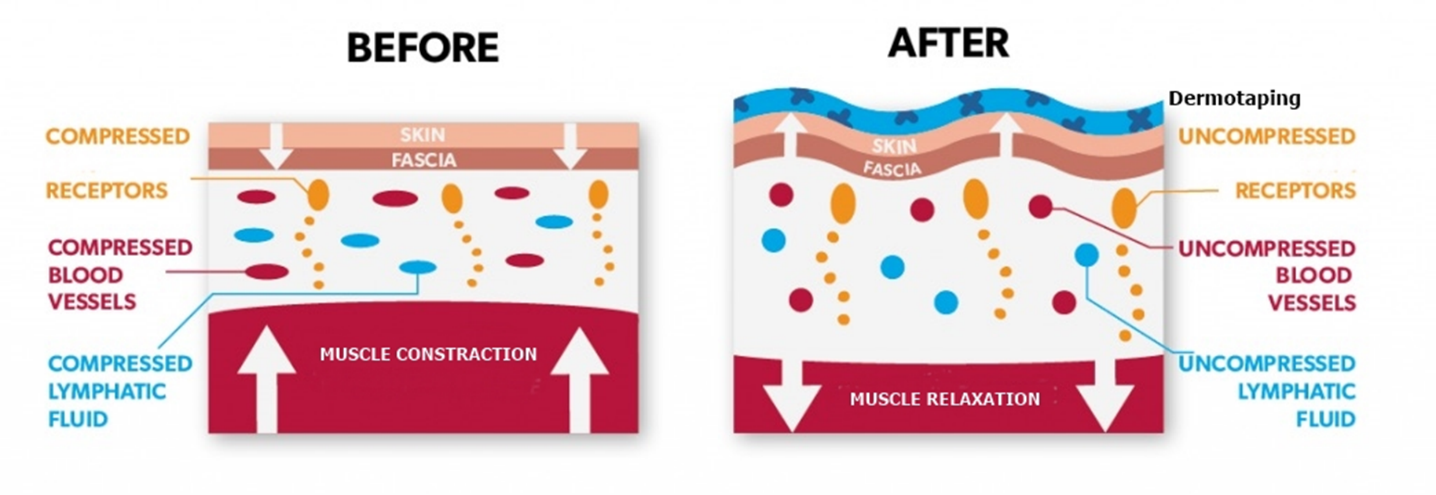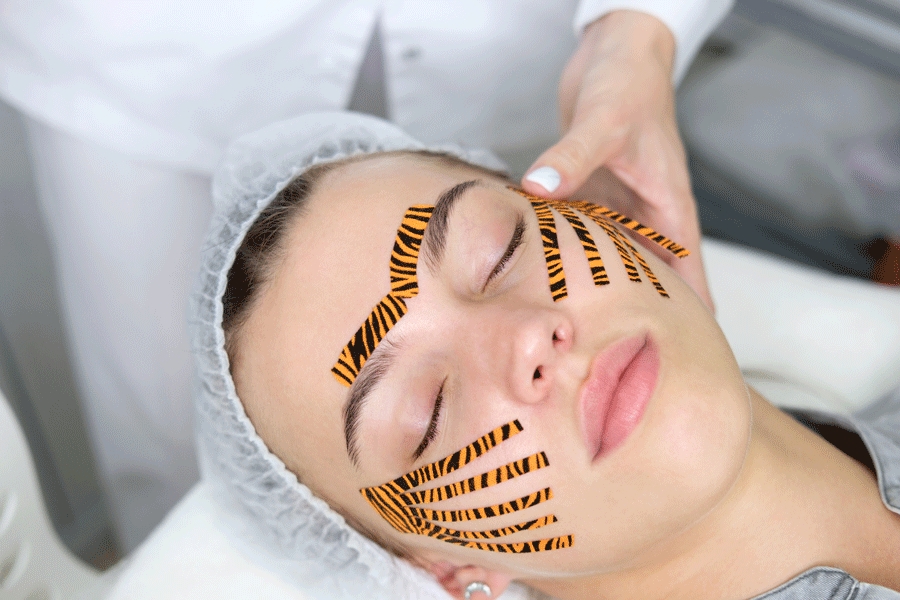Stick to It: Incorporating Dermotaping into the Spa
Written by Morag CurrinDermotaping is an advanced modality that can be integrated with many other treatments already used in the medical aesthetic and cosmetic area. Treatments are non-invasive and a natural approach that uses a bio-mechanical taping system to improve oxygenation of skin and underlying connective tissue.
Many people, when they see images of tape, immediately associate the tape with physical therapy, physiotherapists, or sports medicine. However, we need to clarify that kinesio taping is a stretched tape technique, while dermotaping is applied completely without stretch on the tape. Skin folds form on the surface of the body where the tape is applied.
The dermotaping technique is based on the concept of facilitating skin and muscle motion to achieve biomechanical therapeutic effects in areas to be treated. The application method, combined with a person’s body movement, induces micro-movements in the tape that then stimulate receptors in the skin and underlying layers. These receptors transmit external stimuli to the central nervous system. Through this stimulation, the taping reduces blood and lymph stasis, improves local microcirculation, and favors the absorption of edema. By lifting skin, the process enlarges the interstitial spaces in the tissues and improves circulation and fluid absorption, while reducing pressure on the subcutaneous tissues.
Tissues and systems in our bodies are made to align with each other and, when in harmony, all systems and tissues function to their optimum ability. These same systems and tissue, through injury, trauma, poor posture, stress, or other means, put pressure on the lymph, vascular, and connective tissues; they go out of alignment and start to perform sluggishly due to compression.
This chart shows a comparison of the skin before taping and after taping.

Dermotaping is an adjunct treatment for facial wrinkles and can guarantee an improvement in skin tone, thickness, and coloration in the treated area. If we have improved circulation and lymph function to an area, we are bound to see improvement to that area. Additional skin related issues, such as skin blemishes, localized adiposity, lack of tone, breast stretch marks, Bell’s or facial palsy, double chin, aging lines, and problems related to poor blood and lymph health, can be addressed.
Dermotaping can be used to use in difficult situations like trauma, cosmetic surgery, and burn victims, as the system helps to increase oxygenation to the skin and drainage – meaning the scars are more nourished and the scarring results are better. Just ensure you work within the scope of your license.
The tape is applied in strips and does not cover the whole face, but the necessary areas and the adhesive base is water-based acrylic, so it does not irritate or negatively damage the skin or skin microbiome. The role of the glue is to make sure the tape actually sticks to the skin, as the effectiveness increases the longer a person has the tape on the skin. Ideally, keep the tape on for one to eight hours each treatment and for at least eight treatments.
Tape applied on the body is not really seen; however, it can create constant oxygenation to the skin and lymphatic drainage and reduce fatty tissue buildup. Taping on the face, neck, décolléte, or other visible areas can have a beige color tape applied so that it does not stand out significantly. Book treatments for later in the day, so the client can go straight home with tape on their face and neck.
Removing the tape does not hurt if removed correctly and not vigorously pulled off the skin. Being that the tape is cut into narrow strips, it does not pull on large areas of skin.
Clients looking for instant gratification would not find this holistic approach to their satisfaction. Botox and fillers create internal compression on the skin giving the less wrinkled effect and dermotaping gives improved oxygenation and nutrition to the skin giving a more nourished effect. Dermotaping strives to nourish the skin, internally maintaining the facial expressions that are often reduced with fillers and Botox.
In the end, it is a question of type of market and what clients are looking for. Dermotaping cannot compete with the immediate effect of Botox or a filler, often with the side effects of facial expressions which they feel are not their own and which need time and more treatments to normalize. But, dermotaping can assist the client who wants a natural aging process.
And, dermotaping can help post-Botox and fillers to assist in normalizing facial expressions.
References
Blow, David. Neuromuscular Taping – from Theory to Practice. New York: Ermes Milan, 2012.
Wallen-Russell, Christopher. “The Role of Every-Day Cosmetics in Altering the Skin
Microbiome: A Study Using Biodiversity.” (2018).
 As a leader in our industry, Morag Currin has spent over 25 years in the wellness industry, researching and learning about cosmetic chemistry, advanced skin analysis, reflexology, aromatherapy, and other modalities. She is the pioneer for oncology aesthetics globally and she researches and teaches to inspire professionals who want to make a positive impact on their clients living with cancer. She is the author of “Oncology Esthetics: A Practitioner’s Guide” and “Health Challenged Skin: The Estheticians’ Desk Reference” and her work has appeared in numerous national and international publications. More than an aesthetician, she is a sought-after speaker who loves being a trailblazer. She also continues to reach out to those suffering from a variety of health challenges through equine therapy.
As a leader in our industry, Morag Currin has spent over 25 years in the wellness industry, researching and learning about cosmetic chemistry, advanced skin analysis, reflexology, aromatherapy, and other modalities. She is the pioneer for oncology aesthetics globally and she researches and teaches to inspire professionals who want to make a positive impact on their clients living with cancer. She is the author of “Oncology Esthetics: A Practitioner’s Guide” and “Health Challenged Skin: The Estheticians’ Desk Reference” and her work has appeared in numerous national and international publications. More than an aesthetician, she is a sought-after speaker who loves being a trailblazer. She also continues to reach out to those suffering from a variety of health challenges through equine therapy.
